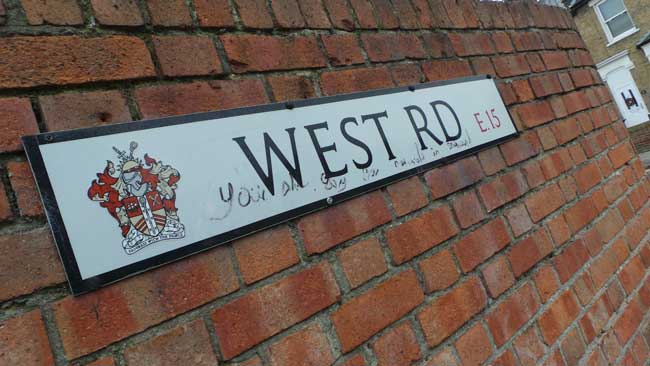Today sees the anniversary in 1890 of the finding of the body of a fourteen-year-old girl named Amelia Jeffs, in West Ham, East London.
MISSING SINCE 31st JANUARY
On Friday 31st January, Amelia had been sent out to purchase a fish supper from a shop in Church Road, about a quarter of a mile from where her family resided.

When she failed to return, her concerned parents launched a search of the neighbourhood and, by the next afternoon, the police were also looking for her.
Her fate would remain unknown for almost two weeks.
Then, on Friday 14th February 1890, two police officers searched some empty houses in the neighbourhood, and they found her partially decomposed body in a cupboard.
She had been violated and then strangled.
Over the next few weeks, suspicion would focus on a particular family that had connections with the empty houses in one of which her body had been found.
Indeed, in an upcoming blog, you will be able to read and study inquest and press reports to see if you agree with the contemporary, implied, consensus that a member of this family had committed the murder.
OTHER WEST HAM DISAPPEARANCES.
However, hers was just one of several mysterious disappearances that afflicted the residents of West Road, in West Ham in the late Victorian era. For, in the early 1880s, two other girls had also gone missing from the very same street and no trace of them had, nor has, ever been found.

Their names were Mary Seward and Eliza Carter and, their disappearances have baffled true crime buffs for over a century, just as they baffled the police, press and public in the late 19th century.
All sorts of tantalising snippets of information about the disappearances have come to light, but no definitive solution has ever been put forward to explain the West Ham Vanishings.
MORE QUESTIONS THAN ANSWERS
There was, for example, the dress of one of the victims that was found in West Ham Park, with all the buttons deliberately cut off.

There was the army major who swore he had seen one of the girls being dragged through the streets of Portsmouth by a hideous old woman, whom he thought might have been a man in disguise.
There was the chemist who was caught red-handed trying to lure children away from the local streets by offering them what turned out to be drugged sweets.
There was also the suggestion in one newspaper that the girls had in fact been traced to Belgium.
Sadly, however, many of these tantalising clues end up leading nowhere, and often result in more questions than they do answers!
THE EPIDEMIC OF VANISHING LONDONERS
Collectively, these mysterious cases have become known as “The Epidemic of Vanishing Londoners” and, in piecing together the known facts of each case, we find ourselves confronted with a mystery to equal that of the identity of Jack the Ripper and one that, in many ways, throws up more disturbing connotations than the ripper crimes ever did,
LONDON BY GASLIGHT
In his 1963 book London By Gaslight, Michael Harrison had this to say about the mysterious disappearances:-
“The epidemic of the Vanishing Londoners began in 1881, the very year in which the first arc-lights went up in the City.
The strange aspect of the disappearances, which were mostly centred about the London districts of East Ham and West Ham, was the absence of what we may call an “age pattern.” Young girls, young boys, middle-aged men and elderly women – all appeared to be equally acceptable as prey to whoever – or whatever – was whipping the victims away. There were, apart from the fact that the persons had disappeared, other factors linking the disappearances.
In many – though not all – cases where children had disappeared, the children had been seen talking to an old woman (description unsatisfactorily vague in all cases where witnesses swore they had seen her) or the old woman had been noticed somewhere around the place where the child had last been seen.
Another disturbing oddity about the disappearances was that one or two of the girls seemed to have had some sort of premonition that ‘something was going to happen’; but that, asked by friends why they were hanging around the streets, so near their homes, and didn’t go home, they gave evasive answers and moved off…but not to go home.”
Sadly, Michael Harrison’s description of the disappearances was somewhat exaggerated, not to say inaccurate in several of its facts, and was based on a chapter entitled “Urban Napoleon Stanger and the West Ham Disappearances,” in Elliott O’Donnell’s book Strange Disappearances (1927), which itself was rather exaggerated and featured several inaccuracies.
In the upcoming series of articles, you will be able to read source material, including inquest transcripts and press reports from the time in order to build up a detailed picture of the events surrounding each of the cases.
WAS ONE OF THE GIRLS FOUND?
Although nothing is known of the fates of Mary Seward and Eliza Carter, a gruesome discovery in a box at a carrier’s office in Goswell Road, London, in 1883 led to speculation that at least one of the girls had been found.
We’ll discuss this find, as well as other tantalising clues on all four cases.
The articles will use press and police reports to piece together the case and, wherever possible, you will be able to view contemporary illustrations that will show the chief protagonists in each case, from the victims to their parents, to the police who investigated each case.
BE SURE TO STAY TUNED
Over the course of the next few blogs, each of these cases will be the subject of a series in-depth, detailed articles which will present the known facts about each one of the disappearances.
The first will look at the case of Mary Seward, who disappeared in April 1881.
The next article will deal with the disappearance of Eliza Carter, who vanished in January 1882.
We will then present the details of a baffling case from 1883 when the finding of a teenage girl’s bod inside a box in a London carrier’s office led to speculation that the remains of one of the two girls may have been found.
There will then follow a series of detailed articles on the murder of Amelia Jeffs in which you will be able to study all the known facts and decide for yourself whether or not her murderer was known but was unable to be brought to justice due to a lack of evidence.
In short, you’ll be able to conduct your own investigation into a series of Victorian cold cases.
So be sure to follow our blog over the next two weeks as we set off on the trail of the Vanishing Londoners.
The articles are both intriguing and illuminating, shining a light, as they do, on other crimes that were taking place in East London around the time of the Jack the Ripper murders.
